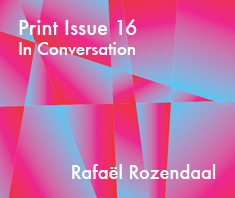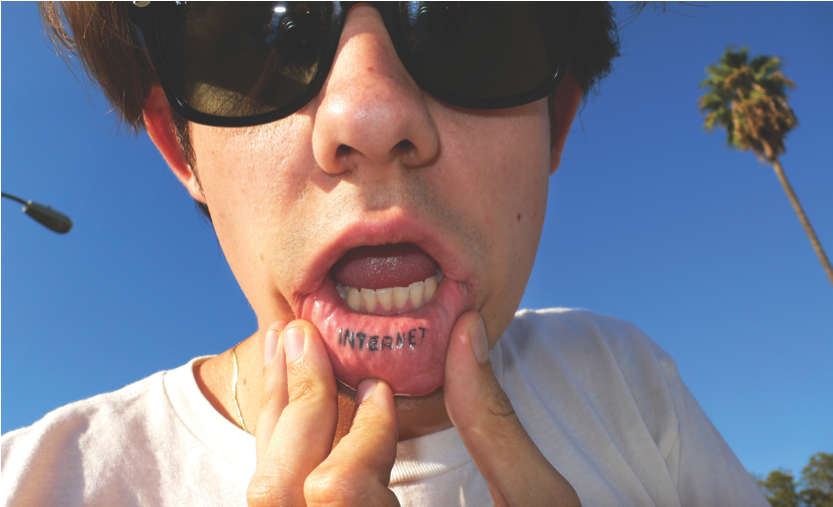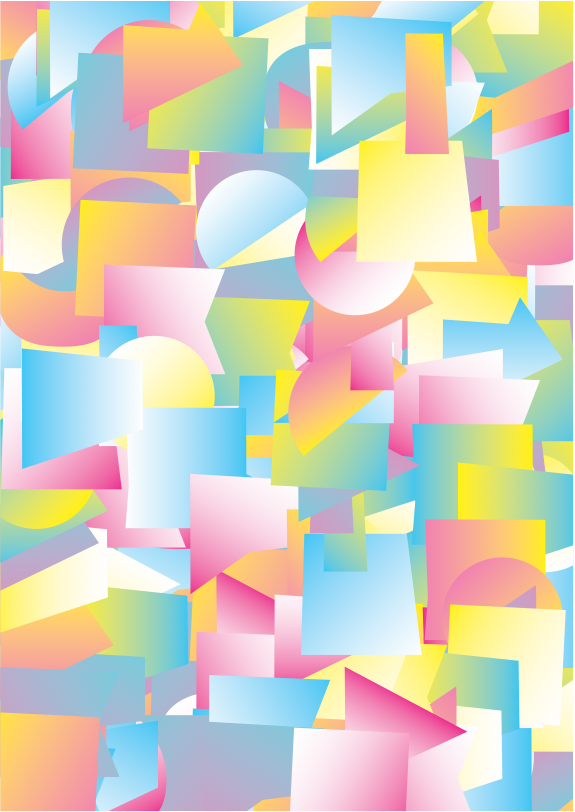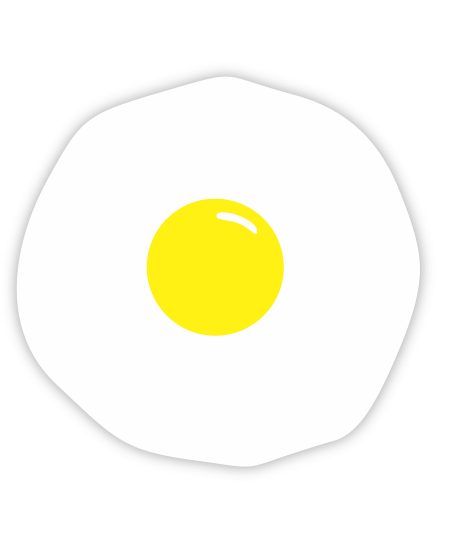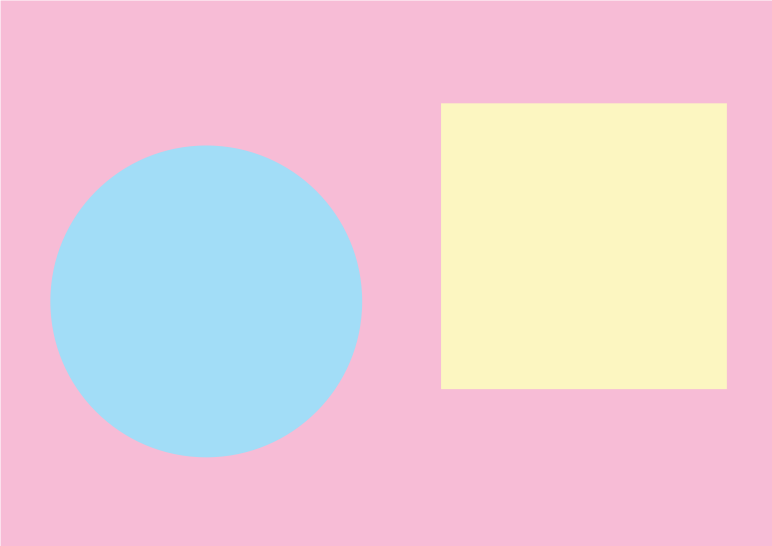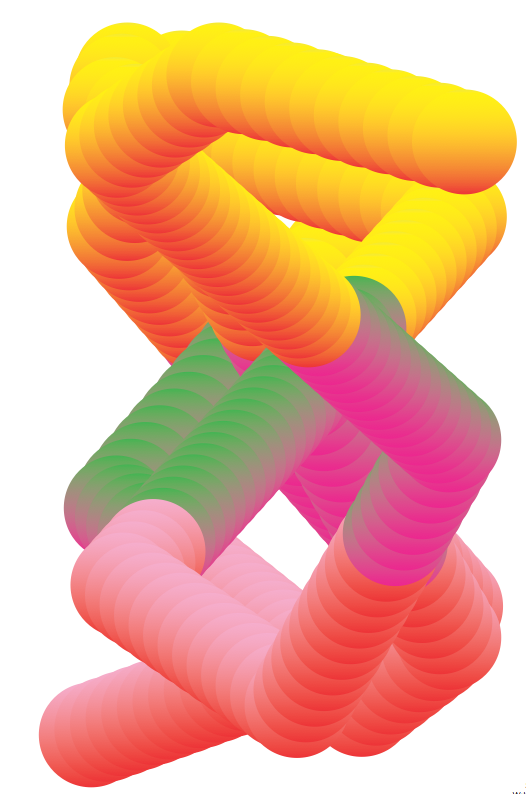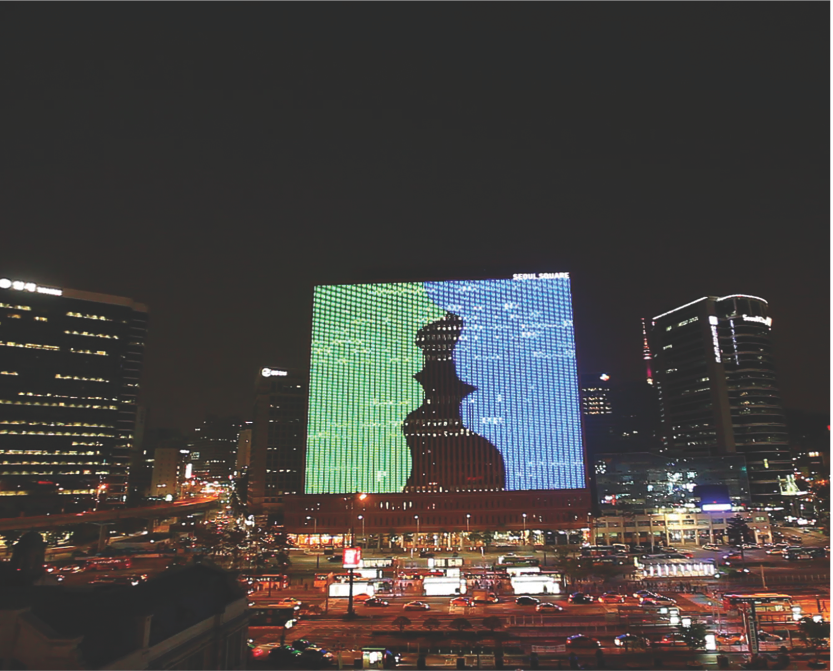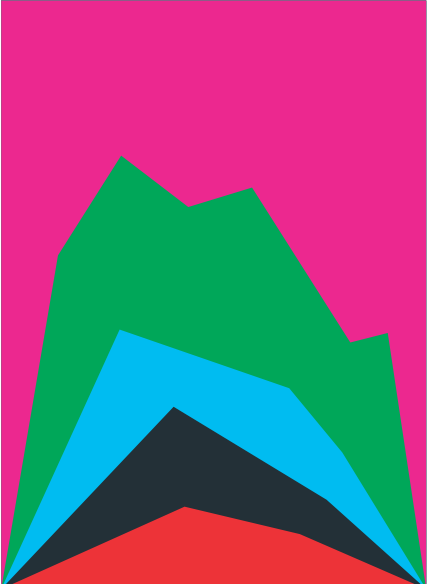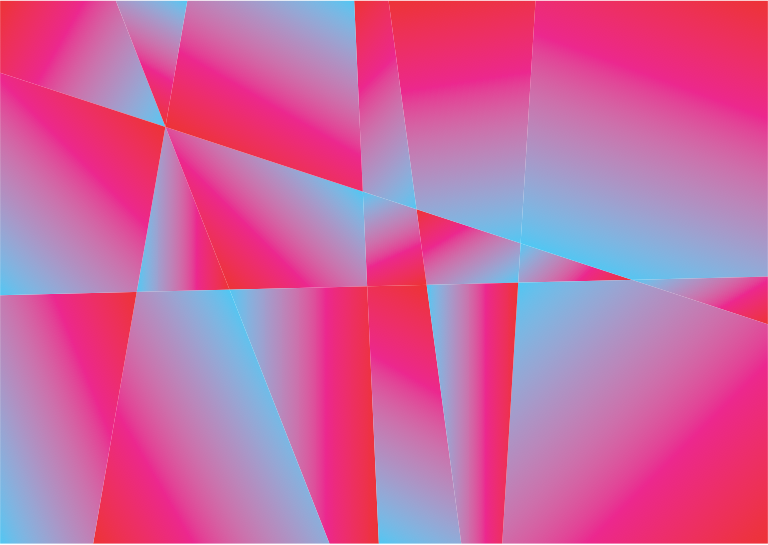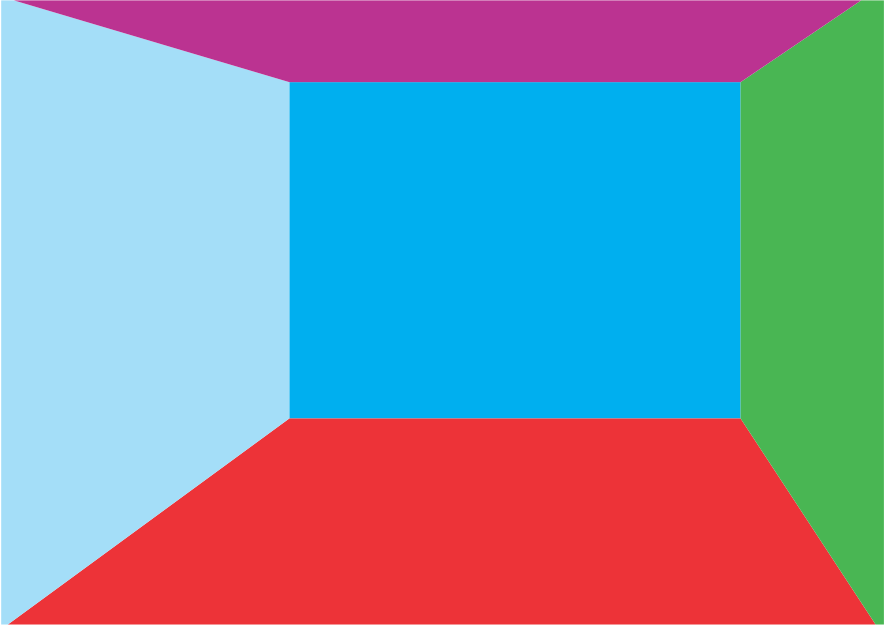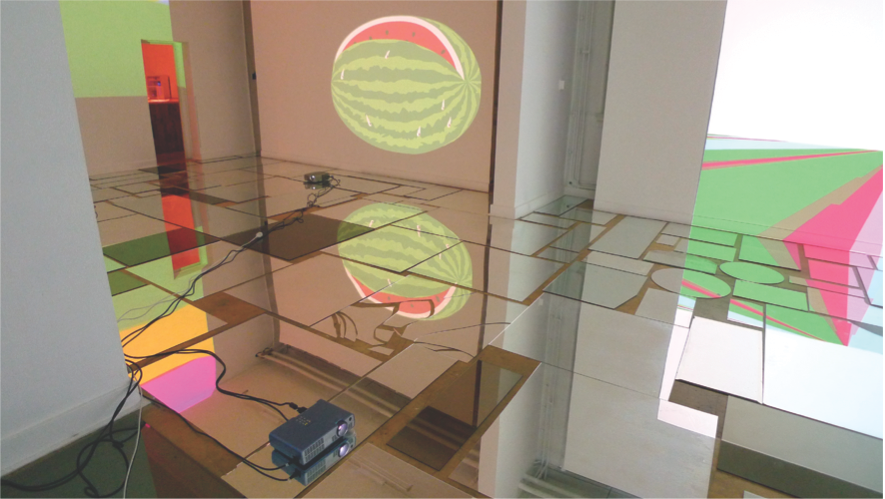In Conversation with Austin Lee
This piece is selected from SFAQ Print Issue 16.
Your artwork has strong ties to both painting and animation. How do you think about time in both mediums and how does it function in your work?
I’m interested in movement, and I’m interested in staring. That means I want to make moving images that don’t have a beginning or ending, no specific duration. The computer makes it possible to create images that run infinitely, always a bit different but also kind of the same. Think of a fountain: it’s in motion, it’s moving, but it’s not going anywhere.
I love that paintings are immediate, opposed to video art. To see a large number of video artworks, you’d have to spend five to ten minutes with each piece. Paintings are different, you scan the works quickly, and stop wherever you want and dive into that work. Once a painting catches your eye, there is a heightened connection between you and the work, a special focus. I’m always looking for that kind of concentration. The concentration of painting, the liveliness of animation.
The Internet has its own pace. When we surf the web, we forget about time. You might see a hundred websites in five minutes, or stare at a single page for an hour. You’re in a state of trance. The best way to experience time is to ignore it. You know that feeling when you’re excited and concentrated and before you know it hours have passed? That’s what I want to present in my work. I hope that people feel that way when they browse my websites.
What amazes me is that time is absolute, but the perception of time varies so much. Some days fly by and some days drag on forever. It’s our personal perception of time that we have to live with.
How many people visit your websites each year? How do you interpret this information? Do you use data to understand how people are looking at your work?
In the last twelve months all my websites combined had 34,746,414 unique visits. Isn’t that insane? I don’t know what to think of it. It’s pretty abstract. That’s a lot more visits than most museums get per year. And I’m just one artist. Having a website, for me, is like having a continuous solo exhibition, in the whole world at the same time. It blows my mind that that’s possible.
If anything, it makes me feel independent. I created Internet art over the years and more and more people shared that content, because they enjoyed it, because they felt it was worth sharing. That’s very moving to me. It’s very moving because it’s shared by people who decide they want to share it, not because an art consultant told them it’s a good investment.
The average viewer spends thirty-four seconds on each page. That’s quite long! Some people told me they will have my work up on a second monitor or TV and just leave it on all day, as a companion, as a permanent work. Some people just flip through them quickly. I do the same when I visit a museum, I walk through the rooms quickly, and if something catches my eye, I’ll spend more time observing and learning.
FlyingFrying.com can be projected as big as a wall or as small as a cellphone. Are you interested in these variables or is it just part of the medium that must be dealt with?
I always thought websites should behave like gas, they should fill any available space. It’s interesting to make a work that deals with different screen sizes. . . . How do you deal with composition? How big is a website? It’s different every time.
Think of music, you can listen to it on headphones while you jog, or in a packed stadium. It’s the same song, different experience. Both experiences are important. I feel the same way about websites. There is no ideal way to view the work, each way is important. You might see my work on your phone, or on a screen the size of a skyscraper, for the whole city to see. I hope that my work is robust enough to stand on its own in any context. That’s what I’m trying. I love seeing the work in different places, it’s different every time.
Is there a story behind your newrafael.com domain?
I started with the domain whitetrash.nl. My very first domain name, 2001. I have no idea why. . . . I was surprised it was available. But after a while it didn’t feel right, it’s a funny name, but not a name for my homepage, for my base. I registered rafaelrozendaal.com with a very cheap webhost who later went bankrupt, so I lost that domain. Rafaelrozendaal.com is too long anyways, and I thought I need some kind of short “rafael” domain name. Most options were taken. . . .
Mai Ueda is great at finding domain names and she came up with newrafael.com. I loved it right away and was surprised it was available. Since then I’ve used newrafael as my handle for all my social media.
If there’s any interpretation the obvious one is that my first name is Rafaël, just like the Italian Renaissance painter. I was born a few centuries later so I’m new. My parents are artists so they must have known what it means to name your child Rafaël. I remember my drawing teachers in art school always had high expectations because of my first name. I’m not that good at live drawing but I enjoyed it. If anything, I had a nice line, a lively hand, but I don’t have a natural talent for drawing people.
I’ve always been drawn to mechanical drawing, using drawing in a mathematical, diagrammatic way. Converting perceptions and ideas into formulas, equations, and diagrams.
Mathematics is really quite beautiful and mysterious. The basic idea of an infinite line that stretches farther than you can imagine. What a beautiful mental image! Anything you imagine . . . it stretches farther than that. Much farther. I love that infinity, by definition, is incomprehensible. If you could comprehend it, it wouldn’t be infinite.
I love looking at Rafael’s drawings, or any other Italian renaissance painting. But that work is very photographic to me. It’s amazing, but also quite far from me. Perhaps too complex to comprehend.
I feel much closer to earlier works, when things are still a bit clumsy. Primitive works, medieval works, I enjoy moments in art history where the artist is not comprehending everything yet. Maybe comprehension is not the right word, but a certain distance from perfect depiction. I like it when things are exaggerated, abstracted, simplified, summarized, distorted, squeezed into a form that does not try to be perfect.
Yet I love Vermeer and Jan van Eyck. So never mind. Vermeer might be my favorite artist of all time.
I love that your parents named you after Raphael. Another great artist I keep coming back to when I look at your work is Sol LeWitt. Can you talk about his influence?
It’s interesting, the connection is very obvious, but only recently did I really look at his work. I knew it before, but I was always more interested in early abstraction, Mondrian, Malevich. . . .
What is really interesting to me is that LeWitt was making algorithmic images without a computer. That is visionary. I wonder how aware he was of the visual possibilities of the computer when he was making his first instruction pieces. I was always suspicious of minimal art, I felt like it was just a bigger, more polished version of what happened in abstract art forty to fifty years earlier. I still feel that way about a lot of minimal art, but LeWitt is really genuine and innovative.
Your domain names are important since they function as the titles of the work. Does finding an available domain become a challenge? What do you think about the recent addition of new domain extensions such as .boats or .fish?
Finding domain names has always been a challenge. I love it! Obviously names like clouds.com or blood.com were taken. Had I started buying domains in 1985 I might’ve had a chance. But I was only five years old. I should’ve been buying domain names in- stead of playing with Lego. I’d be so rich now! Just like operating systems and browser technology influence my work, so do the availability of certain domain names.
It’s quite a puzzle when I want to find a domain. I use a website called bustaname.com. You enter a number of words and it will show you possible combinations of those words that are available as a .com, .org, .net, etc. I’ll enter words that somehow have something to do with what I’m working on, or how I’m feeling. If I belong to any movement it’s probably emotional abstract art, if that category exists. I always wanted .com domain names. I have a few others, .org, .us, .biz, but I’m always excited to find a good .com.
I’m curious how the domain name system will evolve. There will be lots of new top-level domains but I think .com will be around for a long time, just like 1-800 phone numbers.
You started posting your own haikus online recently. Have you noticed a constant thread in your work that is always present regardless of medium?
I feel very close to Japanese culture. I love being there. I love their interest in simplified imagery throughout the centuries, minimal living, gentleness, incredible food, attention to detail, and an obsession with technology.
I found this classic poem by Basho from the 17th century:
“old pond / frog jumps in / splash”
The frog poem! It really is an amazing piece. What is most incredible is that it doesn’t require any material other than human memory. It’s so simple, anyone can remember it. And every time you recite it, it generates this powerful mental image. It will never deteriorate. It will evolve with us.
This inspired me to start writing haiku. I might be a bit clumsy, but I hope to improve over time. I love that I can make them anywhere, you really don’t need any tools to make a haiku. It just appears in your mind. If there is any constant thread in my work, you call that the artist’s vision, right? That always intrigued me: through art we can experience someone else’s perceptions, thoughts, feelings. We can see through someone else’s eyes.
I hope that there is a constant in my work, regardless of medium. I hope my personality is present in my work. Then again the work forms my personality. I don’t think about it too much, I want to make things without analyzing myself, I don’t see any reason for that. I actually see a danger in self-analysis, it makes an artist too reserved and strategic, as opposed to free and spontaneous.
It sounds obvious, but I really just try to do whatever interests me, and try not to think of the potential reward. Because if I’m doing what I love, I’m spending my time the way I want to. And that is the reward.
What do you think of Google Glass or Oculus Rift? Do you think these wearable devices will catch on? How do you feel about computers becoming more integrated with our bodies?
It makes a lot of sense, we all love computers, why not have them integrated into our- selves? I’m not sure if the future will be “any surface is a screen” or “Internet directly in my brain.” I usually wait for a technology to become mainstream, I don’t want to figure out the bugs. I’m really waiting for magic screen paint, so your entire home can behave like a screen.
One of my favorite things you have done is your BYOB project. I love how an idea can become huge and still maintain its simplicity. Are you surprised with how it has grown? Have you noticed a difference in how people share ideas online vs. in person?
Yes I was and am very surprised!
Let me tell you a bit about how it started: I was living in Berlin, and I noticed that most of my friends own projectors. So I thought, let’s find a space and invite everyone and we can set up a one-night exhibition. . . . Easy.
Exhibitions are usually very serious and heavy, I wanted to create one that was more spontaneous. I told Anne de Vries and he loved the idea, so we organized the first edition together. We did not know it was the first edition of a series, we just tried it. The night went very well. It was very easy to set up because everyone brought their own gear. BYOB is very much about individual responsibility, and spontaneity. Everyone was surprised to see so many projections in one space! It looked like the Internet exploded onto the walls.
Projections are very flexible, you can rearrange them, change scale, change what you’re showing, and this made the exhibition very interesting. The artists would respond to each other, changing what they showed according to what was around them.
After that I decided BYOB should be an open format. I posted the manual online: “Find a space, invite many artists, ask them to bring their projector.” That’s it. It’s a social algorithm.
Since then, there’ve been 162 BYOB’s around the world, in places like New York and London, but also Cuba and Myanmar. Each city has its own character and that reflects in the events and the work shown. It’s a great feeling, seeing so many people happy to exhibit their work. I created this idea to empower people.
The art world is very intimidating, and many talented people are too shy to find a place for their art. I’m hoping BYOB helps those people, so they can find each other and build something together. It’s important to note that BYOB is not a critique of institutions, it’s an alternative.
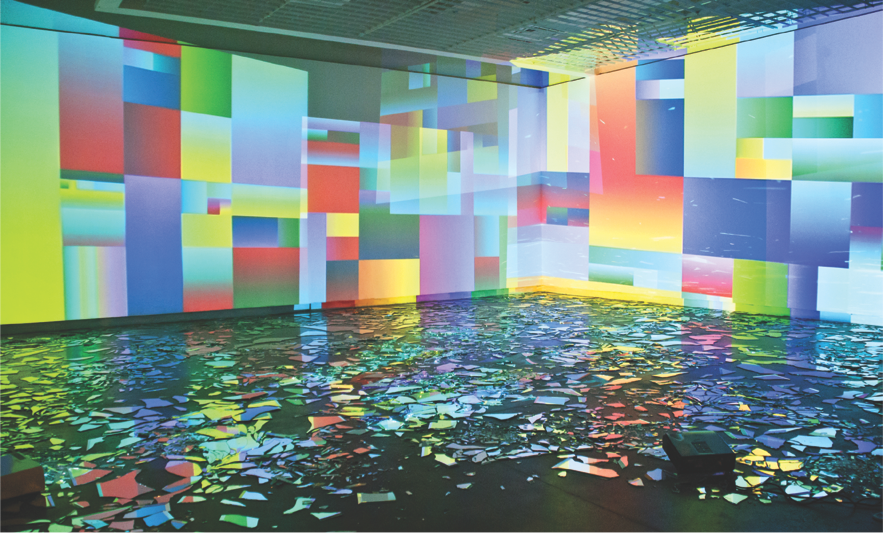
“Into Time,” with mirrors, at Museu da Imagem e do Som, São Paulo, 2010. Dimensions variable, duration infinite. Collection of Nur Abbas. Courtesy of the artist.
When do you know a work is finished?
It’s a feeling. Some works are done right away. They don’t need any fiddling. Some pieces are more difficult. I’ll try different versions, and if it’s not happening, I’ll leave the piece alone for a while. I might leave it for a few days, or even a few years. I’ll look at it every now and then and wait for the final work to present itself. At some moment it unfolds. That’s one of the luxuries of making art, there is no deadline. One thing is for sure, when the work is done, it’s done. It’s very clear to me. I never change a work once it’s done.
What is something you have learned from your mother and father?
They taught me everything. I love my parents, I think I’m very lucky. I’m a product of their interests. They’re both artists and they love to travel. They also taught me a lot about food; your health is mostly what you eat. What also helps to live a good life is doing what you want. When you do what you love, every day is a holiday. Man, it must suck when you don’t like your parents, or they don’t like you. . . .
Hexattack.com made me think of an article I read years ago about strobing images posted on an epilepsy forum. It was the first time I had heard of someone suffering physical harm through the Internet. Your site seems to acknowledge the power, danger, and beauty of color. It is difficult, but the longer I look the more mesmerized I become. Can you talk about how you think about color?
Color is one of those very intuitive things. Words are not very helpful, words are inadequate, I do not have much to say about color. I will say this: words are going to be less dominant in human conversation. Now we carry a smartphone with us, so in any conversation we can show what we’re thinking, instead of saying it. We might show an image or a video, or scribble something, the mobile screen is an alternative to our vocal chords.
My problem with words is that it they are based on the idea of categories, and it creates separations/boundaries that don’t exist. We cannot separate color from rhythm, composition, movement, surface, sound, smell, mood—it’s all one. Words help us to survive, but they also force us to see things a certain way. I think the way we experience reality is heavily manipulated by words, for better or worse.
